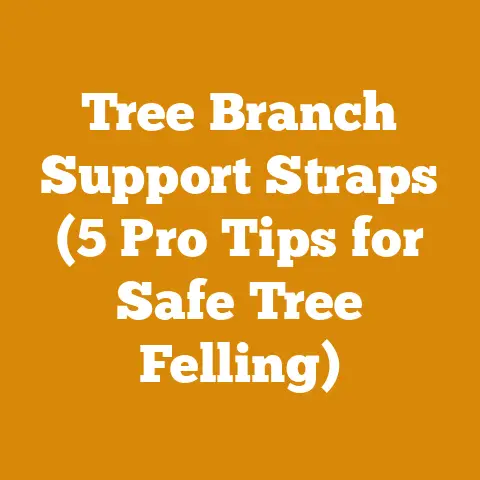DIY Chainsaw Holder for Tractor (5 Expert Tips for Secure Wood Hauling)
Imagine your tractor as a trusty steed, ready to haul the fruits of your labor – logs for milling, firewood for winter, or timber for that dream cabin. But without a proper saddle, your precious cargo is at risk of a tumble. Building a DIY chainsaw holder for your tractor isn’t just about convenience; it’s about safety, efficiency, and protecting your investment. Over the years, I’ve seen firsthand the disastrous results of inadequate chainsaw transport – damaged equipment, lost logs, and, worst of all, potential injuries. So, let’s saddle up and get this done right.
1. Design Considerations: Tailoring the Holder to Your Needs
The first step is to define the specific requirements of your chainsaw holder. This involves assessing your tractor’s capabilities, the size and type of chainsaw you’ll be transporting, and the terrain you’ll be navigating. A one-size-fits-all approach simply won’t cut it.
-
Tractor Compatibility: Consider your tractor’s size, horsepower, and available mounting points. A subcompact tractor will require a lighter, more compact holder than a larger farm tractor. I once tried to adapt a heavy-duty log skidder attachment to a smaller tractor, and the results were comical – and potentially dangerous. The tractor struggled to lift the weight, and the stability was compromised.
- Data Point: Tractor horsepower directly impacts the maximum safe load capacity. Consult your tractor’s manual for specific weight limits. Exceeding these limits can lead to mechanical failure or even rollovers.
- Insight: Three-point hitch systems are common, but not all are created equal. Category 1 hitches have lower weight limits than Category 2 or 3.
-
Chainsaw Size and Type: Determine the maximum bar length and weight of the chainsaws you intend to transport. A small limbing saw will require a different holder than a large felling saw. I’ve seen too many homemade holders designed for a specific saw only to fail when a larger model is used.
- Specification: Chainsaw weight ranges from 6 lbs (small electric) to 25+ lbs (large professional). Bar lengths vary from 12 inches to over 36 inches.
- Tip: Measure the overall length of your chainsaw, including the bar, to determine the minimum length requirement for the holder. Add a few extra inches for clearance.
-
Terrain and Usage: Consider the type of terrain you’ll be operating on. Rough, uneven ground will require a more robust and secure holder than smooth, level surfaces. If you’ll be hauling logs through dense brush, you’ll want a design that minimizes the risk of snagging.
- Case Study: I worked on a project in the Pacific Northwest where the terrain was incredibly steep and rocky. We used a custom-built chainsaw holder with multiple locking points and shock-absorbing mounts to prevent the chainsaw from bouncing out.
- Insight: Vibration is a major factor in chainsaw holder failure. Consider using rubber or polyurethane bushings to dampen vibrations and extend the life of your holder.
-
Mounting Location: Decide where you want to mount the holder on your tractor. Common options include the front loader arms, the three-point hitch, or a custom-built bracket attached to the frame. Each location has its pros and cons.
- Front Loader: Offers easy access but can obstruct visibility.
- Three-Point Hitch: Keeps the chainsaw out of the way but may require dismounting to access it.
-
Frame Mount: Requires more fabrication but offers a stable and secure mounting point.
-
Safety Code: Ensure the mounting location does not interfere with tractor operation or safety features, such as lights, mirrors, or access to controls.
2. Material Selection: Building for Durability and Longevity
The materials you choose will determine the strength, durability, and lifespan of your chainsaw holder. Opting for cheap or inadequate materials is a false economy that will inevitably lead to failure. I’ve learned this the hard way, having had holders made from flimsy materials break under stress, resulting in damaged chainsaws and wasted time.
-
Steel: Steel is the most common material for chainsaw holders due to its strength, weldability, and availability. Choose a steel grade appropriate for the load and stress it will be subjected to.
- Specification: Mild steel (A36) is suitable for most applications. High-strength steel (A572) is recommended for heavy-duty applications or where weight is a concern.
- Data Point: The tensile strength of A36 steel is approximately 36,000 psi, while A572 steel can exceed 50,000 psi.
- Insight: Consider using square or rectangular steel tubing for the frame, as it offers excellent strength-to-weight ratio.
-
Wood: Wood can be used for the chainsaw scabbard or to provide cushioning and support. Choose a durable hardwood, such as oak or ash, that is resistant to rot and decay.
- Specification: Wood moisture content should be below 20% to prevent warping and cracking.
- Tip: Treat the wood with a sealant or preservative to protect it from the elements. I prefer using linseed oil or a marine-grade varnish.
-
Fasteners: Use high-quality bolts, nuts, and washers to secure the holder to your tractor. Avoid using cheap fasteners that can strip or break under stress.
- Specification: Use Grade 5 or Grade 8 bolts for maximum strength.
- Tip: Use lock washers or nylon-insert lock nuts to prevent fasteners from loosening due to vibration.
-
Protective Coatings: Apply a protective coating to the steel components to prevent rust and corrosion. Paint, powder coating, or galvanizing are all viable options.
- Insight: Powder coating is more durable than paint but requires specialized equipment. Galvanizing offers excellent corrosion resistance but can be more expensive.
- Tip: Before applying any coating, thoroughly clean and degrease the steel surface.
-
Rubber/Polyurethane: Use rubber or polyurethane bushings or pads to dampen vibrations and protect the chainsaw from damage.
- Specification: Choose a durometer (hardness) appropriate for the load and vibration level. Softer materials will provide more cushioning but may wear out faster.
- Tip: Consider using recycled rubber or polyurethane to reduce environmental impact.
3. Construction Techniques: Building a Holder That Lasts
The construction of your chainsaw holder is just as important as the design and materials. Poorly executed welds, sloppy cuts, or misaligned components can compromise the strength and safety of the holder. I’ve learned that patience and precision are key to building a holder that will withstand the rigors of wood hauling.
-
Welding: If you’re using steel, welding is the most common method of joining the components. Ensure you have the proper welding equipment and skills. If you’re not comfortable welding, consider hiring a professional.
- Specification: Use a welding process appropriate for the type and thickness of steel you’re using. MIG welding is generally recommended for beginners.
- Safety Protocol: Always wear proper welding safety gear, including a welding helmet, gloves, and protective clothing.
- Tip: Practice your welding technique on scrap metal before working on the actual holder.
-
Cutting and Shaping: Use appropriate tools for cutting and shaping the materials. A metal chop saw, angle grinder, or plasma cutter can be used for cutting steel. A circular saw, jigsaw, or hand saw can be used for cutting wood.
- Specification: Use sharp blades or cutting wheels to ensure clean, accurate cuts.
- Safety Protocol: Always wear safety glasses and gloves when cutting materials.
-
Assembly: Assemble the components according to your design. Ensure all joints are properly aligned and securely fastened.
- Tip: Use clamps to hold the components in place while welding or fastening.
- Insight: Consider using a jig or fixture to ensure consistent and accurate assembly.
-
Finishing: Smooth any sharp edges or burrs to prevent injury. Apply a protective coating to the steel components to prevent rust and corrosion.
- Tip: Use a file or grinder to remove sharp edges.
- Safety Protocol: Always wear safety glasses and gloves when grinding or filing metal.
-
Chainsaw Scabbard: The chainsaw scabbard is the part of the holder that actually secures the chainsaw. It should be designed to protect the chainsaw bar and chain from damage and to prevent accidental contact.
- Specification: The scabbard should be made of a durable material, such as steel or wood. It should be long enough to fully enclose the chainsaw bar.
- Tip: Consider adding a locking mechanism to prevent the chainsaw from falling out of the scabbard. A simple latch or pin can be effective.
4. Safety Protocols: Protecting Yourself and Your Equipment
Safety should be your top priority when building and using a chainsaw holder. A poorly designed or improperly installed holder can pose a serious risk to yourself, your equipment, and others. I’ve witnessed accidents caused by unsecured chainsaws falling off tractors, resulting in property damage and near-miss injuries.
-
Secure Mounting: Ensure the holder is securely mounted to your tractor. Use appropriate fasteners and mounting hardware. Double-check the tightness of all bolts and nuts before each use.
- Limitation: Do not exceed the weight capacity of your tractor or the holder.
- Safety Protocol: Inspect the mounting hardware regularly for signs of wear or damage. Replace any damaged components immediately.
-
Chainsaw Security: Ensure the chainsaw is securely held in the scabbard. Use a locking mechanism to prevent accidental dislodgement.
- Tip: Consider using a chain or cable to further secure the chainsaw to the holder.
- Safety Protocol: Never operate the tractor with the chainsaw running.
-
Visibility: Ensure the holder does not obstruct your visibility or interfere with the operation of your tractor.
- Tip: Position the holder so that it does not block your view of the road or field.
- Safety Protocol: Use mirrors or cameras to improve visibility if necessary.
-
Personal Protective Equipment (PPE): Always wear appropriate PPE when operating a chainsaw, including a helmet, safety glasses, hearing protection, gloves, and chaps.
- Specification: Chainsaw chaps should be made of ballistic nylon or other cut-resistant material.
- Safety Protocol: Inspect your PPE regularly for signs of wear or damage. Replace any damaged items immediately.
-
Emergency Preparedness: Have a first-aid kit readily available in case of an accident. Know how to use the kit and how to call for emergency assistance.
- Tip: Consider taking a first-aid and CPR course.
- Safety Protocol: Keep a cell phone or other communication device with you at all times.
5. Maintenance Best Practices: Ensuring Long-Term Reliability
Proper maintenance is essential for ensuring the long-term reliability of your chainsaw holder. Regular inspections, lubrication, and repairs will help prevent failures and extend the life of your holder. I’ve learned that a little preventative maintenance goes a long way in avoiding costly repairs and downtime.
-
Regular Inspections: Inspect the holder regularly for signs of wear, damage, or corrosion. Pay close attention to welds, fasteners, and moving parts.
- Tip: Develop a checklist to ensure you don’t miss any important inspection points.
- Insight: Vibration is a major cause of wear and tear. Check for loose fasteners and worn bushings.
-
Lubrication: Lubricate moving parts regularly to reduce friction and wear. Use a lubricant appropriate for the type of material and operating conditions.
- Specification: Use a grease gun to lubricate grease fittings.
- Tip: Consider using a dry lubricant in dusty or dirty environments.
-
Fastener Tightening: Check the tightness of all fasteners regularly. Tighten any loose bolts or nuts.
- Tip: Use a torque wrench to ensure fasteners are tightened to the proper specification.
- Insight: Over-tightening fasteners can be just as damaging as under-tightening.
-
Corrosion Prevention: Protect the steel components from rust and corrosion. Apply a protective coating as needed.
- Tip: Clean and degrease the steel surface before applying a new coating.
- Insight: Consider using a rust inhibitor to prevent corrosion in humid environments.
-
Repair and Replacement: Repair or replace any damaged components immediately. Do not operate the tractor with a damaged chainsaw holder.
- Tip: Keep spare parts on hand for common repairs.
- Safety Protocol: If you’re not comfortable making repairs yourself, hire a qualified professional.
-
Wood Moisture Management: If your design incorporates wood, proactively manage moisture content. Firewood, for example, should optimally have a moisture content between 15% and 20% for efficient burning.
- Data Point: Wood with moisture content above 25% burns inefficiently and produces excessive smoke.
- Tip: Store wood under cover and allow for adequate air circulation to promote drying.






